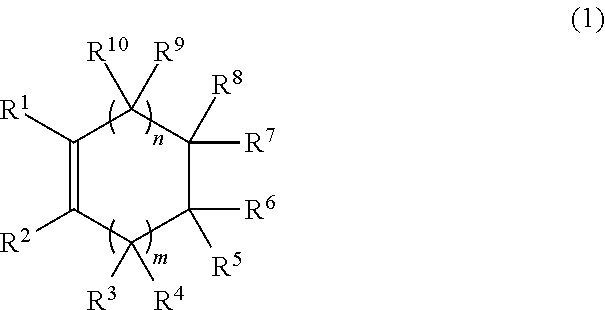Process for production of hydrogenated polymers and hydrogenated polymers
a technology of hydrogenated polymers and polymers, which is applied in the field of hydrogenated polymers and hydrogenated polymers, can solve the problems of resin coloring, increase the amount of adsorbents to be used, and reduce heat resistance, so as to reduce catalyst efficiency, reduce catalyst efficiency, and reduce residual ruthenium content. convenient and economic
- Summary
- Abstract
- Description
- Claims
- Application Information
AI Technical Summary
Benefits of technology
Problems solved by technology
Method used
Image
Examples
example 1
[0092]A 500 mL glass three-necked flask equipped with a stirrer and a thermometer was substituted with dry nitrogen, and a solution containing 5-cyclooctene-1,2-diol (45 g, 0.32 mol), cis-4-octene (197 mg, 1.76 mmol), cyclohexanol (157 g) and THF (58 g) (solution-1) was placed therein.
[0093]Benzylidene(1,3-dimesitylimidazolidin-2-ylidene)(tricyclohexylphosphine)ruthenium dichloride (11.9 mg, 14.0 μmol) was dissolved in THF (10 g), added to the above-mentioned mixed solution, immediately, and ring-opening metathesis polymerization (ROMP) was performed at 55° C. 1 hr later, disappearance of 5-cyclooctene-1,2-diol was confirmed by the analysis of gas chromatography (GC-14B manufactured by SHIMADZU Corporation; column: G-100 manufactured by Chemicals Inspection & Testing Institute, Japan). Then, cyclohexanol (30 mL) was added to the reaction mixture to give a solution (solution-2).
[0094]The above-mentioned solution-2 was continuously added at a rate of 5 mL / hr into a 100 mL autoclave ad...
example 2
[0095]By an operation similar to that in Example 1 except addition of triethylamine (1.0 g, 9.9 mmol) after completion of the polymerization, a polymer (44 g) having a number average molecular weight of 58,000 was obtained. The hydrogenation ratio of the obtained hydrogenated polymer was 99.2 mol % by 1H-NMR analysis. In addition, the ruthenium residual amount was not more than 1 ppm by ICP emission method.
example 3
[0096]By an operation similar to that in Example 1 except addition of triphenylphosphine (1.0 g, 3.8 mmol) after completion of the polymerization and feeding rate of 7 ml / hr, a polymer (44 g) having a number average molecular weight of 58,000 was obtained. The hydrogenation ratio of the obtained hydrogenated polymer was 98.3 mol % by 1H-NMR analysis. In addition, the ruthenium residual amount was not more than 1 ppm by ICP emission method.
PUM
| Property | Measurement | Unit |
|---|---|---|
| partial pressure | aaaaa | aaaaa |
| partial pressure | aaaaa | aaaaa |
| hydrogen pressure | aaaaa | aaaaa |
Abstract
Description
Claims
Application Information
 Login to View More
Login to View More - R&D
- Intellectual Property
- Life Sciences
- Materials
- Tech Scout
- Unparalleled Data Quality
- Higher Quality Content
- 60% Fewer Hallucinations
Browse by: Latest US Patents, China's latest patents, Technical Efficacy Thesaurus, Application Domain, Technology Topic, Popular Technical Reports.
© 2025 PatSnap. All rights reserved.Legal|Privacy policy|Modern Slavery Act Transparency Statement|Sitemap|About US| Contact US: help@patsnap.com



